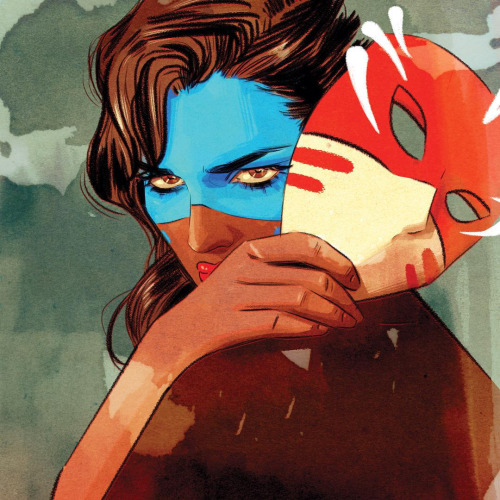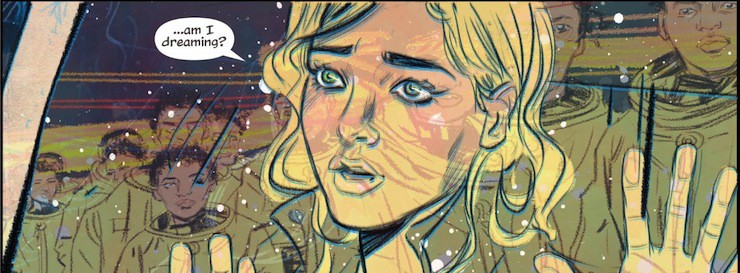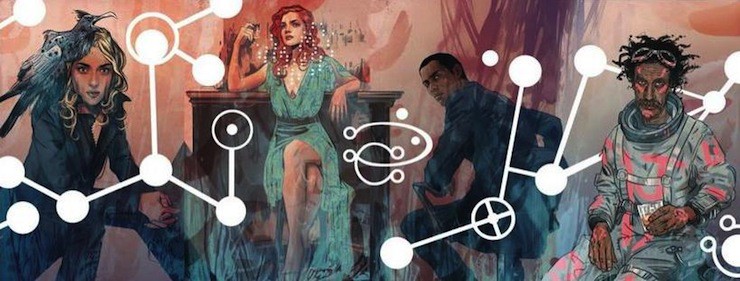It might have seemed to some readers that Tula Lotay burst onto the comics scene from nowhere with her gorgeous art for the Warren Ellis-penned Supreme: Blue Rose, but she had already contributed work to such diverse titles as American Vampire, The Witching Hour, and Red Sonja—and, not incidentally, had founded the Thought Bubble comics festival, now one of the UK’s top comics conventions. I met with her after negotiating the terrifying badge line at San Diego Comic-Con on Wednesday, and talked with her about her work with Warren Ellis, her process, and the ways in which the internet has been—believe it or not—good for women in comics.
How did Heartless come about, after Supreme?
Obviously Warren and I really enjoyed working together, and it was actually last San Diego [Comic Con] that we met up in Hollywood … From that we ended up talking about a lot of cinema that we loved, which we’d discussed previous to that. We were talking about Tarkovsky, the Russian filmmaker. And so he must have gone away and thought about that, and I told him about a really nice hardcover book you can get of Tarkovsky’s polaroids, which is just these beautiful images. He went away and got that and he came back and said “I think we should do something Tarkovsky-esque, something heavy with folklore, northern England, set in the woods,” and I said “this is absolutely my thing, it sounds perfect.” And he went away and came back with this incredible story that I’m super excited about.
Can you talk about how things like British folk horror and folklore fit into this?
The British folklore, yeah, absolutely, it’s going to be based heavily on those kinds of ideas. I don’t want to talk about the ones we used at the moment, because it might give too much away, but it’s going to be absolutely steeped in British folklore, northern British folklore…some of the tales are so incredibly dark, incredibly juicy, and you can work them into stories in such a wonderful way, and it’s going to be a very dark fairy tale.
I was wondering how Image works, how the pitch works, how the story development works—do you and Warren go to them and say “we have an idea”?
I think that’s how it works for a lot of people but with [Warren and I], Eric came to us … I think Eric really liked what we did on Supreme, and he was really really keen to lock us down to do something else with him, something that we’d do ourselves, put everything into. Supreme—it kind of was our story and we absolutely put everything into it, but at the end of the day we were working with Rob Liefeld’s story as well so there are constraints there, and even though those constraints were really interesting and it’s wonderful fitting these characters into this new world, we both thought it would be incredibly to do something from scratch … creating something dark and moody.
Image seems to be a really good home for that kind of thing.
Yeah they really do give great artistic freedom to do whatever they want to do. That’s something that I need really; I really enjoy working that way, if I go into something knowing that there are constraints or I’m going to have things sent back a lot for revisions…I don’t feel like I’m doing my best work in that way, because I can start something and I’m always worrying if it will be okay for them, and so I never kind of fully explore what I want to do. But working that way is interesting as well, you learn a lot doing that.
As an artist, what is one thing that you wish that readers knew about what it is to be a comics artist?
That’s a really hard question … Right now I’m working in a temporary cupboard, on my own most days, and I’m lucky because I work right next to the moors; it’s beautiful up there so I get to go out. I think that’s why things like Twitter have taken off so much for the comics community because people that work on their own a lot get to talk to one another as they’re going along, and that’s always a nice thing.
But yes, it can be quite a solitary way to work and I think when you’re doing any creative endeavor, your ego can be a little fragile sometimes. When you’re pouring your heart into something, you do worry about how it will be perceived—and you can’t really, you have to do what you want, but you want people to like what you do and that’s really important. So I guess maybe it’s nice for anyone reading something, whether they like it or not, to understand that the majority of people of put their heart into it and I don’t think anyone does anything unless it means a lot to them.

It’s the same for writers or really anyone who puts anything of themselves out there; you’re only human, you want it to be liked. You’ve got the Wicked + Divine issue coming out—how was it coming on to this series that has such a devoted fan following?
Really really scary, because obviously Kieron and Jamie and Matt have created this incredible story and there’s so many fans, and living up to Jamie’s work is a pretty scary thing, because he’s so good at what he does, and people are going to be used to that kind of style, which is just always so polished and beautifully colored by Matt. So I always look at my style—and sometimes it’s kind of messy and scratchy; that’s kind of the way I work, and I like it like that—but it is quite different to Jamie’s and it’s a big worry, wondering how their fans are going to react to what I’ve done. I really hope people like it. The story is just breathtaking.
What else are you looking forward to doing?
Obviously I just want to focus on Heartless right now, because I want to give that everything. I’m working on a lot of covers as well … I don’t know how much I should say, but Becky Cloonan and I talk a lot. She’s so amazing and we get along so well, and we’ve been talking a lot about doing something pretty soon so that’s pretty exciting. And I’ve also beent talking to Ales Kot about doing something in the future.
But there’s also a story I started writing years ago that I’ve always wanted to go back to. And I decided to turn it into a comic book, and I started it just before everything exploded with my comics career, so I haven’t done anything with that. Everything I do, I always think about that and going back to it, because it’s a story that I really love and it’s something that I want to do, and I’d probably do that with Image, soon hopefully.
Sounds like you’ve got plenty to keep you busy in the interim there
I’m so busy. I need to start learning how to say no! It’s crazy. Before i just came out—I’ve been traveling the States for five weeks—I did Wicked and the Divine and seven covers in a month before coming out. it’s the most grueling thing I’ve ever done.
It’s one thing for a writer who can work on multiple scripts. It seems like a writer has more room to do that kind of thing than an artist; the demands on an artist’s time are much more intense.
Well, I’m not a writer so I don’t know, and maybe writers would get mad at me for saying this, but how long must it take to write a page? I mean I imagine you could write a whole issue in maybe a day? They’re going to be so mad with me—maybe not a whole issue in a day, but you know what I mean. If it’s flowing, it’s possible—it would never be possible with an artist. And for me, really to do my best work, I need to spend two days on a page, from beginning to end, coloring as well.
I noticed in Supreme, it is very layered and meticulously built up.
Oh thank you! Thanks very much. People have said a lot of the time that I have a really unique style in that, and I’ve never really thought about it; I’ve just gravitated towards the kind of drawing that’s easiest for me, because drawing can be quite hard. I love the look of traditional art so much, but on Supreme a lot of it was digital and I needed to find a way to bring that into it. I love the textures of watercolors so I’d spend a lot of time painting watercolor textures on paper, scanning it in, and then I’d have my digital line work and I’d lay it over the top, and I’d have a paper base and so as you’re working, all these paper textures are coming through and I think it gives it quite a traditional feel.
In the first issue of Supreme you mentioned you’d switched over from doing pencils to all-digital.
Yeah, and it’s just a matter of time really. I think really if I had the time I’d want to use ink because inks are beautiful; as you’re drawing with ink mistakes happen that are really nice and it’s just lovely to use, but with time constraints it’s so so tough to do that. So that’s the way I work. It’s scanned brown paper usually, digital line over the top which is a custom brush, and then just normal color flats, all in Photoshop with CS5, and then I add watercolor layers over the top and put them in overlay on multiply and it kind of puts a nice texture over everything. And then maybe touch it up at the end.

What are you reading right now?
Right now, since I’ve started drawing comics, I read less than I ever have; I don’t have time to do anything else, I’m so busy—but the things I’ve really really loved recently are This One Summer by Jillian Tamaki—that was incredible, it’s so moving, this snippet of two young girls’ lives meeting on a summer holiday….Also Through the Woods, Emily Carroll, that’s a collection of online spooky horror stories that she did. She’s just amazing. I’m really really enjoying Outcast by Robert Kirkman and Paul Azaceta—that terrified me. I was reading the graphic novel right before going to bed and it scared the crap out of me… The Wicked and the Divine and Zero, I’m a big fan of that. Rocket Girl—Amy Reeder’s amazing. Shutter’s fantastic—I love Leila del Duca’s work on that. And some of the new DC stuff as well; that’s incredible, like Gotham Academy and Batgirl—those guys are doing super cool things. And Black Canary is amazing; the first issue blew me away. Annie Wu’s incredible.
There’s a lot of really interesting stuff going on in comics right now and in particular a really amazing breadth of female talent.
It is, and that’s really exciting…I’m just so pleased it’s happening, and I think it’s a natural progression. As things are talked about more and more in the media and online about women’s involvement in comics and we see more and more girls taking an interest in that and more material for girls—not even for girls but that’s more inclusive for them—it’s a natural thing that that new generation of people already are going to be inspired to start working on things more, and it’s lovely.
I’m suddenly aware that everything I’ve mentioned about inspiration, the majority of people I’ve talked about have been women. That actually is an intentional thing from my point of view, I really do feel like there’s a lot of women out there who are creating a lot of the best stuff in the industry right now, they’re doing amazing work.
It seems to me too that with a lot of women there’s a willingness to not fit into convention. Your work, Annie Wu’s, Kate Beaton, Noelle Stephenson—it’s really exciting and makes for a much better experience as a reader.
I agree completely, and I don’t know if this is part of it…but they’re coming from a place where they haven’t been through the conventional means to start drawing comics. I remember when I was getting into comics, when I tried in the past, there was always this idea—I’ve always been a big fan of Marvel and DC, which are just incredible, some of my favorite characters and I’m super happy to work with them—but there was always this idea that for me to get into the industry I would have to be a penciller or an inker or a colorist. And certainly if you’re doing a monthly comic you do have to compromise along those lines because it’s such an intensive workload. But a lot of females coming into the industry maybe started reading graphic novels and exploring comics differently, maybe digitally, especially the younger generation. I think if you’ve not grown up with those typical penciler-inker-colorist ideas, you maybe feel more free to do it.
Going back to what you were saying about Twitter creating a community around solitary work, would you say Twitter, Tumblr, etc. are also a means that allows this artistic movement to happen?
Absolutely, because anyone can post their work online, and anyone can make connections online or show work to other people. And if what you’re doing is good and stands out, people will start paying attention and they will take notice, and that’s a wonderful thing to do. It’s almost like publishers have been taken out of the equation. And I think that publishers are very important, they have their place, and I wouldn’t want them to disappear… But when you look at Noelle Stephenson, and something like Nimona, she’s doing everything herself. She’s creating this digital comic online through her own means and that piece of work there that she’s loading up—it’s one of the best stories. She’s doing that without the help of anyone else and that’s an incredible thing to be able to do, and to be respected and noticed for it as well. It’s a great achievement.
Note: this interview was edited for length and clarity. Some material published earlier has been edited on request.
Karin Kross has just returned from her seventh SDCC, and she, her husband Bruce, and her friends Shellie and John are posting about SDCC at nerdpromnomnom. She can be found elsewhere on Tumblr and Twitter.










